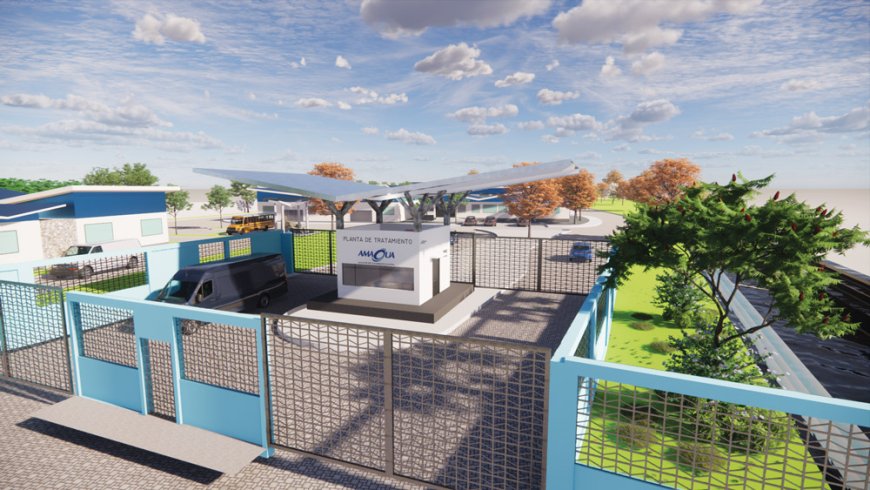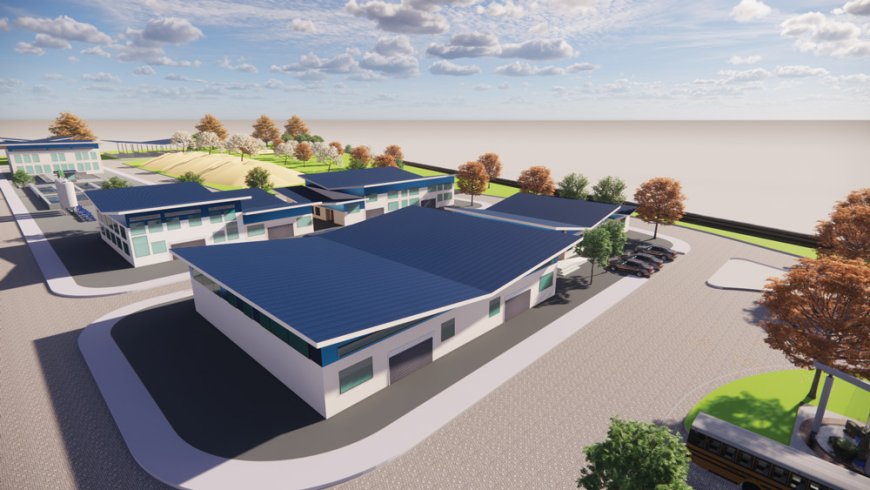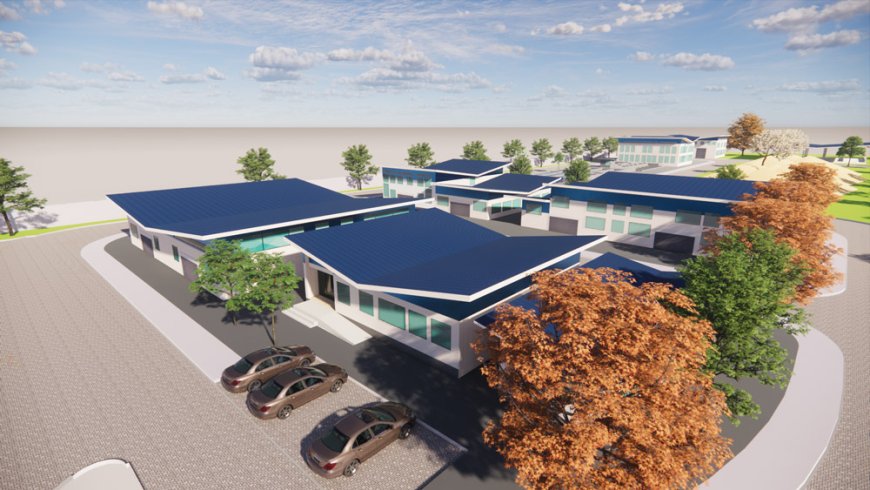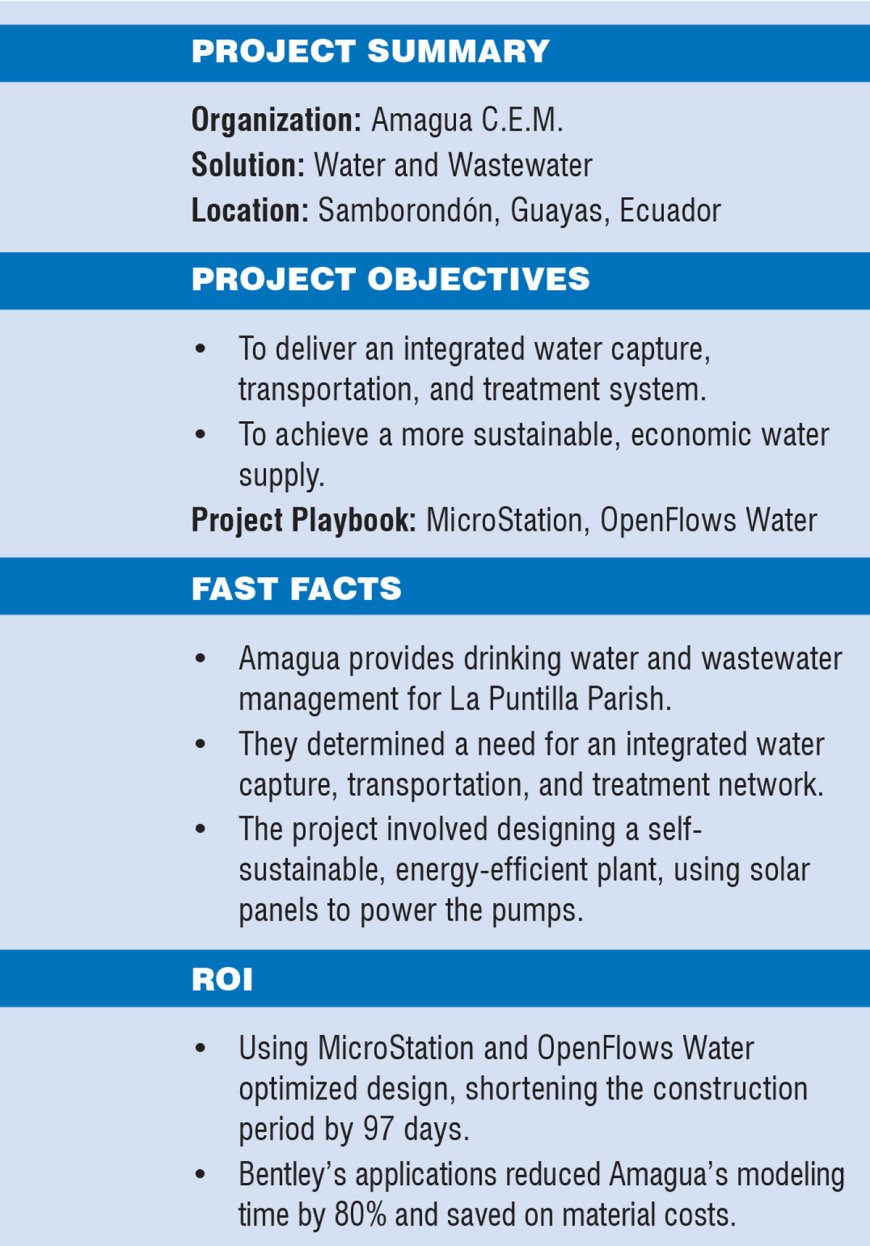Solar-powered Water Treatment and Distribution Network

Amagua C.E.M. provides drinking water and wastewater management for the La Puntilla Parish in the Samborondón district of Ecuador. Committed to offering a quality, efficient water supply and sewerage service, they also provide complementary preventive system management, as well as consulting for network design, construction, and maintenance of residential facilities. To streamline operations and ensure a reliable water supply, Amagua decided to build an integrated water capture, transportation, and treatment system. “To have operational autonomy, we determined the need for an integrated collection, conduction, and treatment system that allows it to supply […] a complete flow of 880 liters per second (l/s),” said Leonidas Dávila, Engineer and Project Director at Amagua.

The project was divided into two phases, providing a flow of 440 l/s in the first phase and an additional 440 l/s during the second phase. It involved designing a catchment, distribution line, and treatment plant. To make the project self-sustainable and reduce its carbon footprint as much as possible, Amagua contemplated using solar panels to power the network and pump the water to the distribution tanks. The solar energy captured by the panels would power surface pumps that draw water from a river or well and pump it to the raw water tank and distribution system, reducing and potentially eliminating the network’s reliance on conventional energy sources, such as grid electricity or fossil fuels.

Addressing undulating terrain and pipeline transients
While solar panels are advantageous to reducing environmental impact and supporting a more sustainable and economical water supply, Amagua needed to consider several factors to optimize pump and network operations. “It is important to consider the appropriate capacity and size of solar panels, as well as the efficiency and capacity of storing energy in batteries, for optimal operation of the pump system,” said Leonidas Dávila. In addition to the panel specifications and energy considerations, Amagua also had to address semi-undulating terrain and irregular topography, as well as avoid problems with transients in the 4.2-kilometer-long pipeline in the high elevation area.
To identify and mitigate potential problems that could affect the pressure and flow and compromise operations, as well as ensure that the solar panels could generate the necessary power to deliver a reliable water supply, Amagua had to perform various modeling scenarios. They needed an integrated 3D design and hydraulic modeling and analysis solution to optimize optioneering, determine the most effective network arrangement, and validate the use of solar energy.

Leveraging Bentley’s 3D design and hydraulic modeling and analysis applications
“It was proposed that MicroStation and OpenFlows Water be used to optimize the execution of the project,” said Leonidas Dávila. Amagua selected MicroStation to design the entire architecture of the system in 2D and 3D, as well as OpenFlows Water to model and analyze the pipeline arrangement of the network and estimate energy consumption costs, based on both electricity and renewable energy. The advanced algorithms and 3D visualization features of Bentley’s applications allowed Amagua to perform digital simulations of numerous scenarios, verifying the optimization of both the existing and future distribution networks, and validating the use of solar panels as the most efficient source of renewable energy. “Thanks to the usefulness of OpenFlows Water’s energy cost module, we were able to model energy costs when using fossil fuels and when using solar panels, as well as their contribution to the carbon footprint,” said Leonidas Dávila. The digital models will also be used throughout the construction and operations phases of the project.
Digital simulation reaps savings and supports sustainability
Using Bentley’s advanced 3D design and hydraulic modeling and analysis applications, Amagua reduced modeling time by 80%. Working in a connected digital platform improved efficiency in data federation and data exchange processes by 75% and 80%, respectively. Through accurate modeling and simulation, Amagua shortened the planning stage by 15 days, identifying and eliminating 3,530 collisions during the design phase that was equivalent to a potential savings of USD 50,000. The integrated technology solution shaved 97 days off the construction schedule to save USD 1.2 million while achieving an optimal design that saved 40,000 tons of concrete.
In addition to time, cost, and material savings, the digital simulations supported the use of solar panels, delivering significant environmental and sustainability benefits by reducing energy consumption and the carbon footprint of the project. The solar panels reduced dependency on fossil fuels, eliminating 6,905 metric tons of carbon emissions. “As a result, we were able to achieve a 95% reduction in fossil fuel energy used per year,” said Leonidas Dávila. Compared to conventional pumping systems, the solar-powered pumps are easier to maintain and are especially useful in rural or remote areas where electrical infrastructure may be limited, providing autonomous and reliable access to drinking water, improving the quality of life for communities. “The use of water pumping systems with solar panels offers significant environmental, economic, and social benefits,” said Leonidas Dávila.

Neda Simeonova
Senior Product Marketing Manager, Water Infrastructure, Bentley Systems







